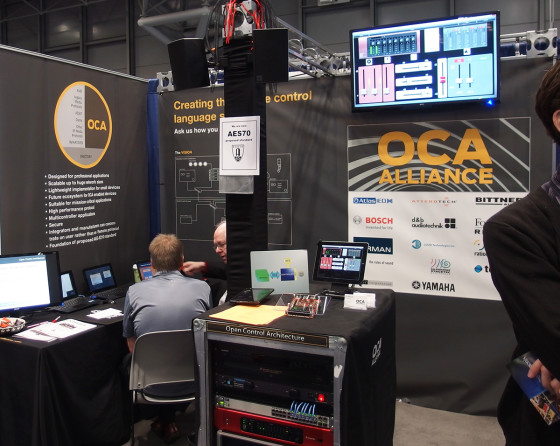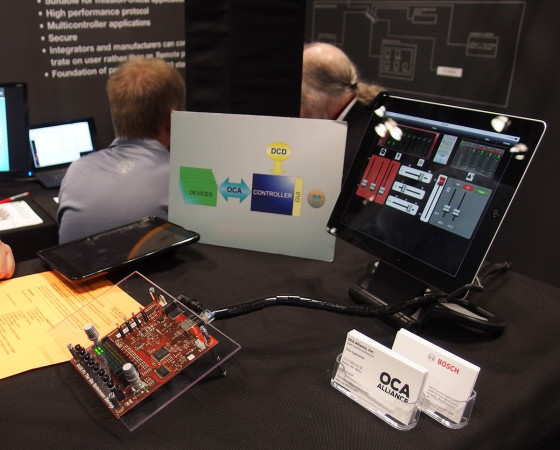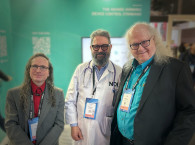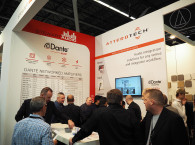OCA Alliance confirmed that Open Control Architecture (OCA) – an open control and monitoring standard for professional audio and AV media network devices – has been officially standardized on 4 January 2016 by the Audio Engineering Society Standards Committee (AESSC) in the newly published AES70-2015 standard for audio applications of networks - Open Control Architecture. With the ratification of OCA as AES70, it is now an official public open standard.

The Audio Engineering Society published the new AES70 audio over IP standard on January 20, 2016. Additionally, a report on the recently conducted AES67 interoperability Plugfest has been released. AES Standards Manager Mark Yonge explained AES70 “follows on to complement the AES67 audio over IP networking standard we published in 2013. It covers quite comprehensively the control and monitoring of audio devices over a network.
Chair for the AESSC, Bruce Olson, comments, “AES70 represents another important step towards the interoperable networked working environment that audio professionals will rely on. The AES will continue to develop the standards necessary to enhance these tools.”
Combining AES70 system control with standard media transport will bring a complete media network solution to the market, one in which devices from diverse manufacturers can readily interoperate. In particular, AES70 includes a complete Discovery specification which will compliment media transport standards and solutions such as AES67. However, AES70 may be implemented with any media transport mechanism, including AVB/TSN and analog cable.
Speaking for the OCA Alliance, Jeff Berryman, chair of the OCA Technical Workgroup and the AES writing group for AES70 says, “The availability of an interoperable control, configuration, monitoring, and diagnostic architecture for media networks will provide new opportunities for highly integrated systems. Such systems will be able to exchange control data and information in ways previously not possible.”
Marc Weber, chair of the OCA Marketing workgroup adds, “This is another major step towards making the OCA / AES70 vision a reality. One where all network devices are talking the same remote control language, AES70. In this emerging world, media system integrators and users will be free to choose the best products for their own purposes, with few compatibility concerns. Systems will have long service lifetimes with rich on-going upgradeability. The OCA Alliance and the AES are looking forward to the growth of a media network ecosystem that will offer standardized system control capabilities for professional audio and AV products and systems.”

Originally proposed as a field-tested specification by the OCA Alliance – a not-for-profit association, of leading professional audio and AV industry manufacturers invested in audio networking, formed to secure the standardization of the OCA as a media networking system control standard for professional applications – the standard has already seen successful implementation in the field on commercially available products from alliance member companies.
Technically, AES70 is essentially the same as OCA 1.3, the specifications for which have been available on the OCA Alliance website since October, 2014 and which has been used in shipping products that have implemented OCA. However, a few changes have been made. Interested parties are encouraged to download the official standards documents from the references given below.
The AESSC is the organization responsible for the standards program of the Audio Engineering Society, publishing a number of technical standards, informational documents and technical reports. Under the AES Standards Committee, working groups and task groups, of fully international membership, engage in writing standards covering fields that include topics of specific relevance to professional audio. Complete information, including scopes of working groups and project status is available at http://www.aes.org/standards.
OCA (Open Control Architecture) is an open control and monitoring standard for professional audio and AV media network devices. From a single device and controller to networks with almost any number of devices and multiple controllers, OCA provides for powerful, high speed, low cost, robust system control and monitoring of devices from different manufacturers. OCA can be used in conjunction with any available transport protocol (Dante, AVB, AES67, Cobranet, etc.). Offering interoperability across different media transports and manufacturers’ devices, it enables whole new levels of complex system integration and options as to how and where network devices can be deployed. The architecture operates on commodity Ethernet networking hardware or via standard 802.11 Wi-Fi.

Control functionality allows system professionals to change and monitor all operating parameters of a network device, including the creation and deletion of signal paths, parameter adjustments for signal processing objects, network device firmware updates and management of access control. Control can also be limited to provide simpler “operator” functionality; for instance, providing just level, mute, power on/off and fault indication. OCA is not itself a media transport, or a means of programming a network device or system control, or generating a user interface. OCA is available free of charge to manufactures, system integrators and designers, to implement with their own and third party network devices, as they require.
The current members of the alliance are Atlas Sound, LP/Innovative Electronic Designs, LLC, Attero Tech, LLC, Bittner Audio Int. GmbH, Bosch Communications Systems, d&b audiotechnik GmbH, Focusrite, Harman Professional Group, LOUD Technologies, Inc., Rational Acoustics, LLC, RCF spa, Salzbrenner Stagetec Mediagroup, TC Group, THAT Corporation, and Yamaha Commercial Audio.
www.oca-alliance.com
More about OCA Alliance’s recent efforts here and here.






